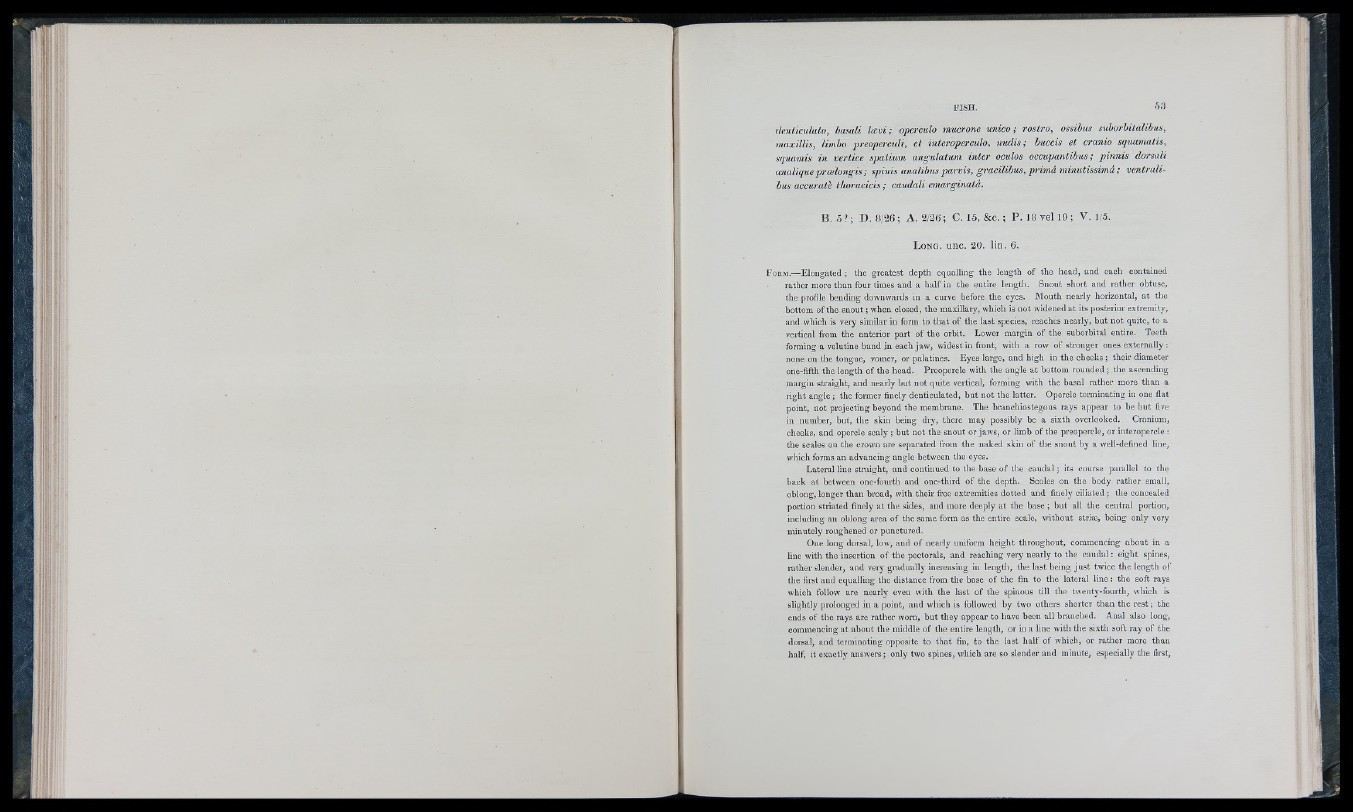
denticulato, basali Icevi; operculo mucrone unico; rostro, ossibus suborbitalibus,
maxillis, limbo preopercuU, et inter operculo, midis; buccis et cranio sqxmmalis,
squamis in vertice spatium angulatum inter oculos occupantibus ; pinnis dorsali
analique proelongis; spinis analibus parvis, gracilibus, primâ minutissima ; ventrali-
bus accuraiè thoracicis ; caudali emarginaiâ.
B. 5 ?; D. 8/26; A. 2/26; C. 15, &c. ; P. 18 vel 19; V. 1/5.
L o n g . u n c . 2 0 . lin . 6.
F o r m .— Elongated ; the greatest depth equalling the length of the head, and each contained
rather more than four times and a half in the entire length. Snout short and rather obtuse,
the profile bending downwards in a curve before the eyes. M outh nearly horizontal, at the
bottom of the snout ; when closed, the maxillary, which is not widened a t its posterior extremity,
and which is very similar in form to that o f the last species, reaches nearly, but not quite, to a
vertical from the anterior part of the orbit. Lower m argin of the suborbital entire. Teeth
forming a velutine band in each jaw , widest in front, with a row of stronger ones externally :
none on the tongue, vomer, or palatines. Eyes large, and high in the cheeks ; their diameter
one-fifth the length of the head. Preopercle with the angle at bottom rounded ; the ascending
margin straight, and nearly but not quite vertical, forming with the basal rather more than a
right angle; the former finely denticulated, but not the latter. Opercle terminating in one flat
point, not projecting beyond the membrane. The branchiostegous rays appear to be but five
in number, but, the skin being dry, there may possibly be a sixth overlooked. Cranium,
cheeks, and opercle scaly ; but not the snout or jaw s, or limb of the preopercle, or interoperele :
the scales on the crown are separated from the naked skin of the snout by a well-defined line,
which forms an advancing angle between the eyes.
Lateral line straight, and continued to the base of the caudal ; its course parallel to the
back a t between one-fourth and one-third o f the depth. Scales on the body rather small,
oblong, longer than broad, with their free extremities dotted and finely ciliated ; the concealed
portion striated finely at the sides, and more deeply a t the base ; but all the central portion,
including an oblong area of the same form as the entire scale, without striæ , being only very
minutely roughened or punctured.
One long dorsal, low, and of nearly uniform height throughout, commencing about in a
line with the insertion of the pectorals, and reaching very nearly to the caudal : eight spines,
rather slender, and very gradually increasing in length, the last being ju st twice the length of
the first and equalling the distance from the base of the fin to the lateral line : the soft rays
which follow are nearly even with the last of the spinous till the twenty-fourth, which is
slightly prolonged in a point, and which is followed by two others shorter than the rest ; the
ends of the rays are rather worn, but they appear to have been all branched. Anal also long,
commencing a t about the middle of the entire length, or in a line with the sixth soft ray of the
dorsal, and terminating opposite to that fin, to the lost h alf of which, or rather more than
half, it exactly answers; only two spines, which are so slender and minute, especially the first,